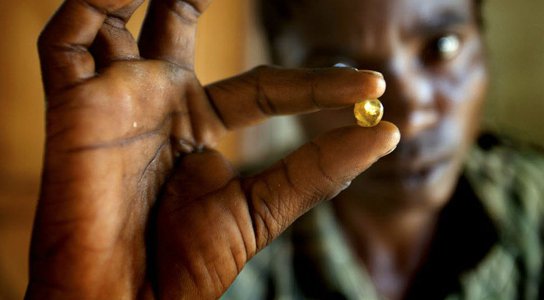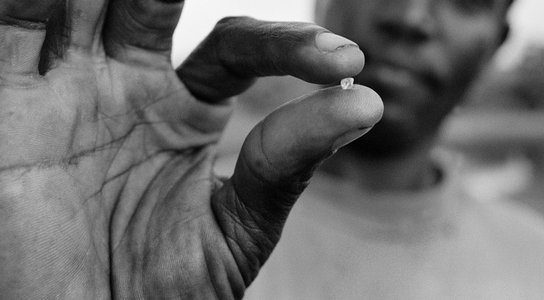There are some big changes afoot in Zimbabwe’s diamond sector. A Chinese backed company, Anjin, part owned by the Zimbabwean army, is set to resume mining in the Marange diamond fields in May this year following a three year hiatus, while Russia’s diamond mining giant Alrosa will reportedly complete setting up its office by the end of this month. For the Government, who are banking on $4 billion in mining revenues for 2019, this must seem like good news. But is it?
In 2016, the Mugabe-led government unceremoniously ejected all diamond-mining companies from the site of the country’s major deposits, the Marange diamond fields in Eastern Zimbabwe. Since then, the diamond industry has wondered what (or who) next for the country’s precious stones. Following the installation of the state-owned and newly created Zimbabwe Consolidated Mining Company, it was hard to see without private investment, how the operation could be sustained.
New investment in the diamond sector comes at a time when the Zimbabwean economy is nosediving and companies in the diamond industry especially—which has a history of bad governance, missing revenues and shady operators—are likely to face a lot of scrutiny. With mass unemployment, high-priced basic goods and dwindling cash supplies, Zimbabwe simply cannot afford to miss out any further on the fruits of its plentiful mineral wealth. Recently, the devastating effects of Cyclone Idai on the country have been intensified by the economic crisis. But if diamonds are to play a role in alleviating economic woe, improved governance of the sector is critical.
Transparency is a critical element in reforming Zimbabwe’s notoriously shadowy diamond sector. Henceforth, responsible management of and investment in the sector should include publication of all diamond mining contracts, shareholdings, and their ultimate beneficial owners; production of timely annual reports, including audited accounts detailing revenues raised and all payments to the Treasury and all transfers to private shareholders. These types of transparency requirements can provide important information to companies and traders in downstream diamond supply chains undertaking supply chain due diligence to ensure that diamonds trade are not linked to corruption or human rights abuses. To keep tainted stones out of global supply chains, this is essential. The behavior of companies is critical if Zimbabwe’s diamond sector can be reshaped as a responsible and reputable industry.
And so to the chosen diamond mining companies. Anjin is making something of a comeback, given its previous operations in Marange. It was one of the mining companies expelled from the diamond fields under President Mugabe. Anjin was originally reported to be a joint venture company between a Chinese company, Anhui Foreign Economic Construction Corporation (AFECC), and the Zimbabwean government when it was licensed in 2010. However, Global Witness’ investigations later revealed that the army held a 40% stake in the company while only the remaining 10% was in fact in the hands of the government. The army’s stake was confirmed during a 2018 enquiry by Zimbabwe’s parliament.
Zimbabwe’s security forces are notoriously politically partisan and have been a key means of keeping the ruling party in power, often through campaigns of violence. They, in turn, have benefitted from the rewards reaped by this. Most recently the army’s brutal reaction following nationwide street protests in January over a dramatic rise in fuel prices was just another in a very long line of crackdowns triggered when the government’s grip on power is perceived to be under threat. The army’s role in the diamond industry has been one of the indications of this mutually symbiotic relationship. The selection of army-owned Anjin to return suggests this dynamic may not have changed.
AFECC’s history in the diamond sector raises questions
Alongside the army, the Chinese joint venture partner in Anjin, AFECC, has resumed their investment, despite apparently having their fingers burnt first time round. On the part of the government, AFECC itself is also questionable choice. The company was invested in a second Marange diamond mine during the Mugabe era, named Jinan. Reportedly, a joint venture with the government, Jinan was mired in controversy over its revenue flows.
In 2018, apparently as part of the new order under President Mnangagwa, the government released an ‘externalisation’ list referring to companies that had illegally failed to repatriate export proceeds—bring money back into the country. Jinan was one of the top five companies named on the list. This followed a very public scandal a few years previously in which Jinan was investigated for illegally sending hundreds of millions of dollars out of the country at a time of ongoing economic privation. However, the outcome of a police investigation into the externalisation issue appears unclear according to local reporting.
Given the players involved, the government’s approval of Anjin as the company to mine Zimbabwe’s precious stones presents numerous concerns about what influenced the decision, where diamond funds may be channeled and for what purpose. It may also speak to the power of the army in the new order.
Alrosa, industry giant enters the sector
Alongside Anjin, the Russian state diamond miner, Alrosa is the other company named as setting up operations in Zimbabwe. While AFECC describes itself as a large-scale multi-operational enterprise, apparently with lots of fingers in lots of pies, Alrosa is solely in the diamond business. It is one of the biggest diamond mining companies in the world with its own mines in Russia as well as some operations in Africa. As one of the giants of the global diamond industry, Alrosa is part of the Diamond Producers Association whose mission is to ‘protect and promote the integrity and reputation of diamonds’ and a member of the Responsible Jewellery Council. It is one of the big companies currently piloting transparency mechanisms in the diamond industry.
Alrosa’s navigation of the business environment will be a test of its commitment to responsible sourcing and may offer some hope to the Zimbabwean people of a better deal on their diamonds. Companies with the sort of clout wielded by Alrosa—and a reputation to protect—must use their influence to advance conditions in which the profits of the country’s precious stones can be harnessed for real value to Zimbabwe’s development and democracy.
For the Zimbabwean government, which is clinging on to its claims of a new era despite mounting evidence to the contrary, future governance of the diamond sector is a test case of its commitments to a responsible and reliable business environment.
Only time will tell in which direction this is all going to go but Zimbabwe’s long-suffering people and the world are watching.


